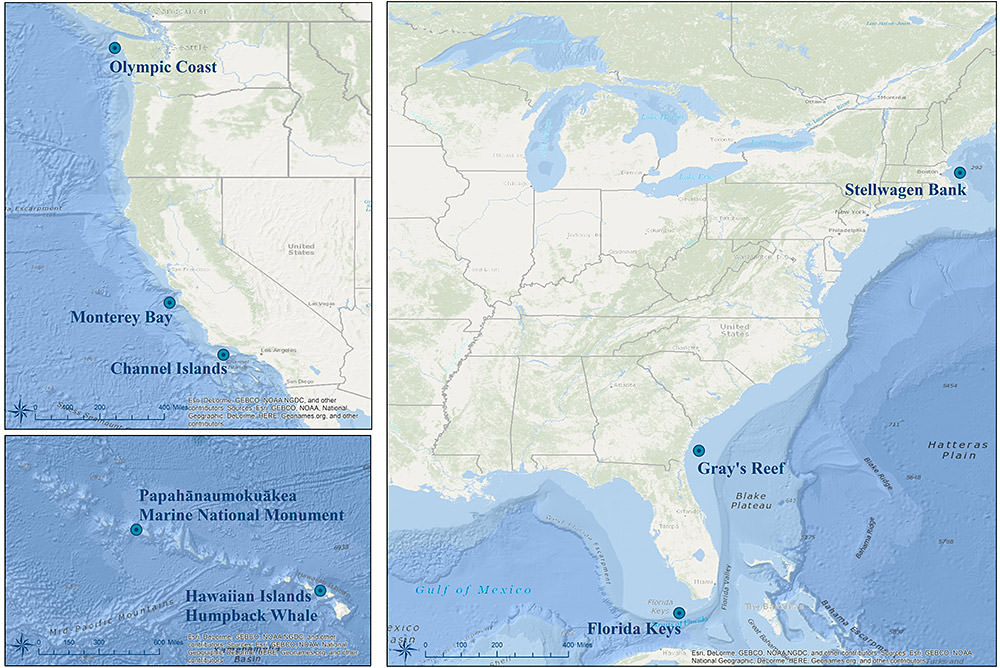Blue Whale Sound Production Recorded at SanctSound Site CI02_01
This record represents blue whale sound production detected from raw passive acoustic
data. Blue whale B calls were detected using Triton's Blue Whale B Call Detector Remora.
The detector uses spectrogram correlation (Mellinger and Clark, 2000) to detect calls
with a kernel (an average B call) that is generated from a subset of calls. The kernel
was calculated from 30 excellent quality B calls that were at least 24 hours apart.
A kernel was generated per sanctuary for every six months of data. Kernel quality
and optimal threshold settings were tested by running the detector through a subsample
of data in which 200-400 calls were manually detected. The comparison between manual
and automatic detections was used to calculate precision and recall of the detector,
in percentages. Settings were considered optimal when precision and recall were both
85% or higher. These settings were then used to run the detector through the entire
dataset for that deployment. Wav files were first decimated to 2 kHz sampling rate.
Detector results were manually verified during time periods in which few detections
were expected.These data were recorded at SanctSound Site CI02_01 between October
31, 2018 and January 13, 2019.
- Cite as: NOAA Office of National Marine Sanctuaries and U.S Navy. 2021. Blue Whale Sound Production Recorded at SanctSound Site CI02_01, SanctSound Data Products. NOAA National Centers for Environmental Information. https://doi.org/10.25921/bnxb-9a34. [access date].
- 10.25921/bnxb-9a34
- NCEI Metadata ID: gov.noaa.ncei.pad:NOAA-Navy-SanctSound_CI02_01_bluewhale
gov.noaa.ncei.pad:NOAA-Navy-SanctSound_CI02_01_bluewhale
| Search Data |
|
| Download Data |
|
| Distribution Formats |
|
| Ordering Instructions | Contact NCEI for other distribution options and instructions. |
| Distributor | NOAA National Centers for Environmental Information ncei.info@noaa.gov |
| Dataset Point of Contact | NOAA National Centers for Environmental Information ncei.info@noaa.gov |
| Dataset Point of Contact | Carrie Wall NCEI Passive Acoustic Archive Lead NOAA National Centers for Environmental Information pad.info@noaa.gov |
| Coverage Description | Site CI02_01 |
| Time Period | 2018-10-31T20:00:00Z to 2019-01-13T15:00:00Z |
| Spatial Bounding Box Coordinates |
West:-120.5232
East:-120.5232
South:34.0856
North:34.0856
|
| Spatial Coverage Map | |
| General Documentation | |
| Associated Resources |
|
| Publication Dates |
|
| Edition | Final SanctSound Data Product |
| Dataset Progress Status | Complete - production of the data has been completed |
| Data Update Frequency | As needed |
| Purpose | These data are available to the public for a wide variety of uses including scientific research and analysis. |
| Dataset Citation |
|
| Cited Authors |
|
| Principal Investigators |
|
| Publishers |
|
| Acknowledgments |
|
| Theme keywords | Global Change Master Directory (GCMD) Science Keywords
|
| Data Center keywords | Global Change Master Directory (GCMD) Data Center Keywords
|
| Platform keywords | Global Change Master Directory (GCMD) Platform Keywords
|
| Instrument keywords | Global Change Master Directory (GCMD) Instrument Keywords
|
| Place keywords | Global Change Master Directory (GCMD) Location Keywords
|
| Project keywords | Global Change Master Directory (GCMD) Project Keywords
|
| Use Constraints |
|
| Access Constraints |
|
| Other Constraints | Cite as: NOAA Office of National Marine Sanctuaries and U.S Navy. 2021. Blue Whale Sound Production Recorded at SanctSound Site CI02_01, SanctSound Data Products. NOAA National Centers for Environmental Information. https://doi.org/10.25921/bnxb-9a34. [access date]. |
| Fees |
|
| Processing Steps |
|
| Instrument |
|
| Platform |
|
Last Modified: 2023-06-15
For questions about the information on this page, please email:ncei.info@noaa.gov
